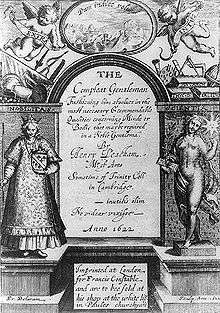Henry Peacham (born 1578)

Henry Peacham (born 1578, d. in or after 1644) was an English poet and writer, known today primarily for his book, The Compleat Gentleman, first printed in 1622.
The son of Henry Peacham the Elder, like his father Peacham was a graduate of the University of Cambridge.[1] In 1603, at the age of twenty-five the younger Peacham was a schoolmaster at Kimbolton Grammar School. In 1612 he published a book of printed emblems called Minerva Britanna, based on a manuscript which is believed to have been presented to Henry Frederick, Prince of Wales, in 1610.[2]
Peacham's The Compleat Gentleman is presented as a guidebook on the arts for young men of good birth. In it, he discusses what writers, poets, composers, philosophers, and artists gentlemen should study in order to become well-educated. Because he mentions a large number of contemporary artistic figures, he is often cited as a primary source in studies of Renaissance artists.
A representative passage from The Compleat Gentleman:
- "For composition, I prefer next Ludovico de Victoria, a most judicious and a sweet composer: after him Orlando di Lasso, a very rare and excellent Author, who lived some forty years since in the court of the Duke of Bavier."

Further reading
- Edward Chaney, The Evolution of English Collecting (New Haven and London, Yale University Press, 2003)
- Horden, J. R. B. (2004). "Peacham, Henry". Oxford Dictionary of National Biography (online ed.). Oxford University Press. doi:10.1093/ref:odnb/21667. (Subscription or UK public library membership required.)
- Alan R. Young, Henry Peacham, Boston: Twayne, 1979.
Notes
- ↑ "Peacham, Henry (PCN592H)". A Cambridge Alumni Database. University of Cambridge.
- ↑ Elizabeth Hageman, Katherine Conway, Resurrecting Elizabeth I in Seventeenth-century England (2007), p. 73
References
- Peacham, Henry (1664). The worth of a penny: or, A caution to keep money. London: S. Griffin, for William Lee, 1664. p. 40. Retrieved 2010-03-24.